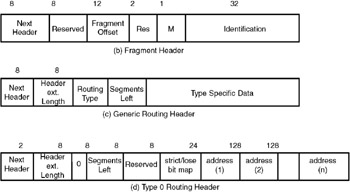21.9 FEATURES OF IP VERSION 6
|
| < Day Day Up > |
|
21.9 FEATURES OF IP VERSION 6
The important features of IP Version 6 are:
-
Increased address space: instead of 32 bits, IPv6 uses an address length of 128 bits.
-
Increased security features.
-
Modified header format to reduce processing at the routers.
-
Capability for resource allocation to support real-time audio and video applications.
-
Support for unicast, multicast, and anycast addressing formats.
-
New options to provide additional facilities.
-
Compatibility with IPv4. However, translator software is required for conversion of IPv4 datagrams into IPv6 packets.
In IP Version 6, the address length is 128 bits. In the future, every desktop, laptop, mobile phone, TV set, etc. can be given a unique IP address.
| Note | IP Version 6 provides backward compatibility with IP Version 4 because a very large number of routers have IP Version 4 software, and it will be many more years before all routers run IP Version 6 software. |
21.9.1 IPv6 Packet Format
In IPv4, the header contains many fields because of which the router has to do lots of processing. In IPv6, some header fields have been dropped or made optional for faster processing of the packets by the router. Optional headers (called extension headers) have been included that provide greater flexibility. Flow labeling capability has been added for real-time transmission applications such as audio and video.
The IPv6 packet consists of the IPv6 header, a number of optional headers, and the data. The IPv6 packet general format is shown in Figure 21.3, and the packet header format is shown in Figure 21.4.

Figure 21.3: IPv6 packet general format.

Figure 21.4: IPv6 packet header.
In IP Version 6, there are many optional headers. Optional headers provide the necessary flexibility. If these are absent, the processing of the header information can be done very fast at the routers.
Version (4 bits): Specifies the version number 6.
Priority or traffic class (8 bits): This field specifies the type of data being sent in the data field. Priority is indicated through this field.
Flow label (20 bits): Audio and video data needs to be handled as special packets for real-time applications. This field specifies the special handling of such type of data.
Payload length (16-bit unsigned integer): Length in octets, and extension headers are also considered part of the length.
Next header (8 bits): This field identifies the type of header following the IPv6 header.
Hop limit (8-bit unsigned integer): This field is decremented by 1 at each node that forwards the packet. When the value in this field becomes 0, the packet is discarded.
Source address (128 bits): This field specifies the source address of the packet.
Destination address (128 bits): This field specifies the destination address of the packet.
IPv6 extension headers: Depending on the requirement, the IPv6 header can be followed by a number of optional headers, known as extension headers. Extension headers are not normally processed by any node except the hop-by-hop option header. If this header is present, it must immediately follow the IPv6 header only. Extension headers must be processed in the order given in Figure 21.5. Figure 21.6 gives the format of different extension headers from which the functionality of each header is obvious, along with the number of bits required for each field.

Figure 21.5: IPv6 packet with all extension headers.

Figure 21.6: IPv6 routing header formats.
If no extension headers are present, the IP packet has an IPv6 header with the next header field containing TCP, followed by the TCP header and data.
The optional headers are called extension headers. If no extension headers are present, the IP packet has the IP header with the next header field as TCP.
If the routing header is to be included as an extension header, the IPv6 header contains Routing in the next header field, followed by the routing header. The next header field of the routing header contains TCP. The routing header is then followed by the TCP header and the data.
The IPv6 format appears complicated, with very long address fields and many extension headers. However, this reduces a lot of the processing burden on the routers, and so the routers can do the packet switching very fast. IPv6 will provide the necessary functionality for real-time audio and video transmission as well as improved security.
However, very few routers and end systems are presently running IPv6 software, and it will be many more years before IPv6 becomes universal. Microsoft Windows XP supports IPv6, and soon most of the operating systems and routers will be upgraded to support IPv6.
|
| < Day Day Up > |
|
EAN: 2147483647
Pages: 313